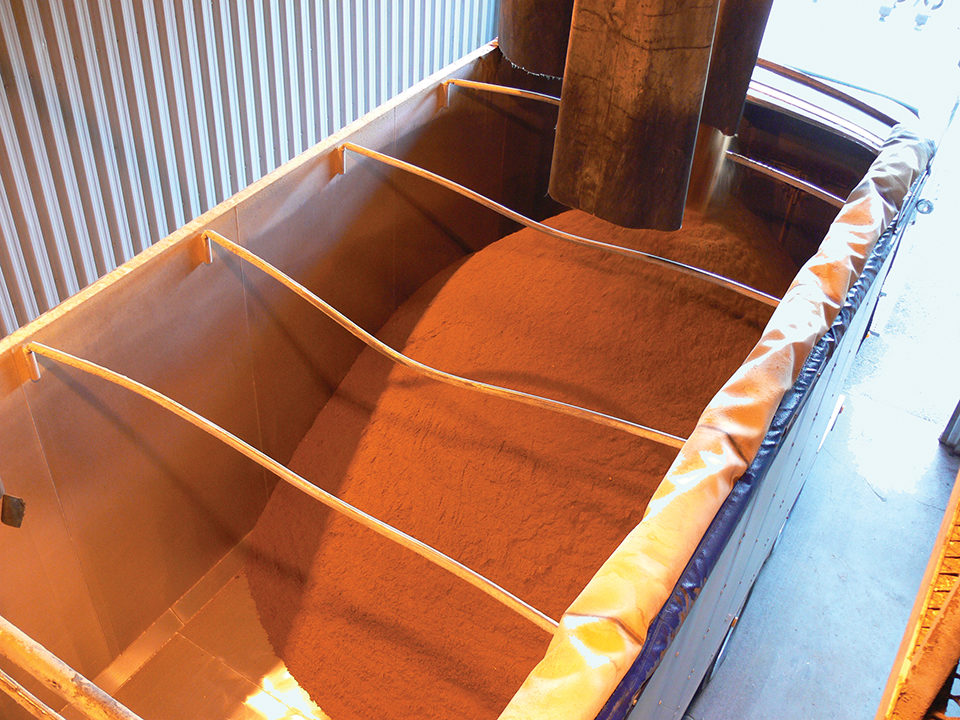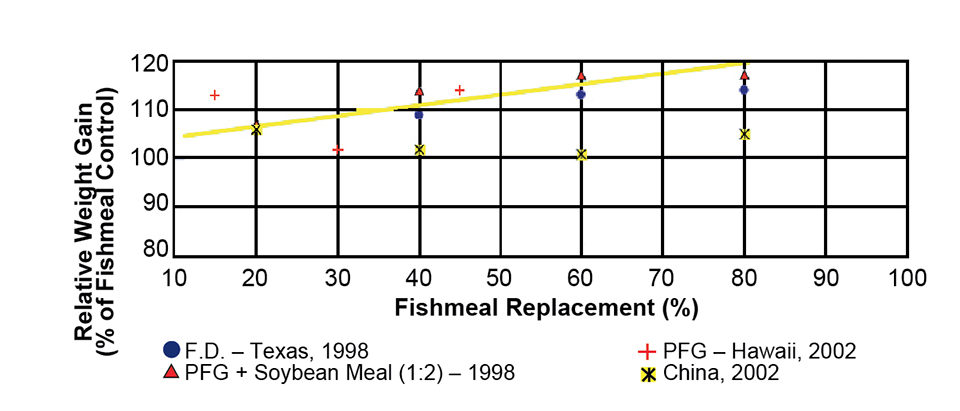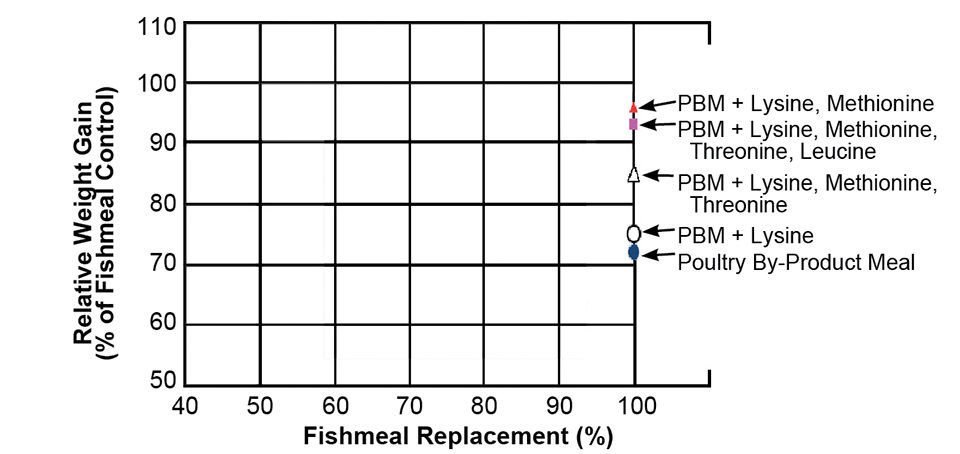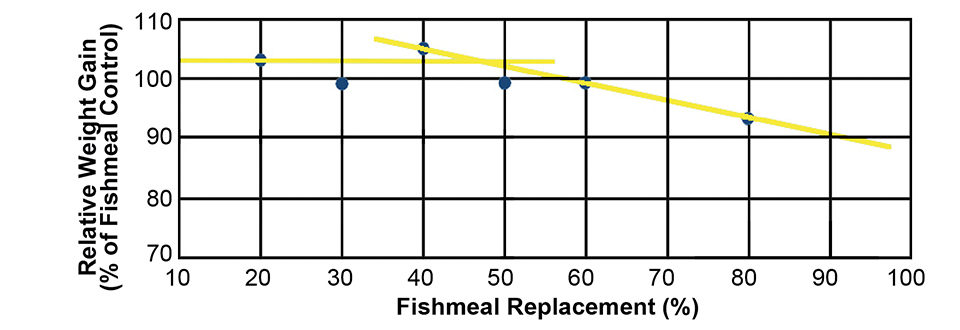Poultry and meat and bone meals help with nutrient requirements, cost effectiveness

Animal proteins are desirable dietary components for carnivorous and omnivorous aquatic animals. While fishmeal has long been the prime protein choice in feed, its future supply will likely not keep pace with the fast-growing aquafeed industry.
Researchers and nutritionists are therefore examining the suitability of various fishmeal replacements. Based on the requirements of individual species, these alternative protein sources must provide biological performance at reasonable cost. Poultry byproduct meal and meat and bone meal are two rendered protein products that could replace fishmeal in diets for commercially important fish and shrimp.
Digestibility
Poultry byproduct meal
Compared to other alternative nonmarine animal proteins, poultry byproduct meal is relatively consistent in quality and has protein and essential amino acid (EAA) digestibilities closest to those of fishmeal.
Since 2004, the nutrient digestibilities of poultry byproduct meal have been measured in Pacific white shrimp (Litopenaeus vannamei); black tiger shrimp (Penaeus monodon); hybrid striped bass; largemouth bass; rainbow trout; sea bass; turbot; and cobia (Table 1). In a trial, the average EAA digestibilities were noticeably higher for L. vannamei than P. monodon (87 and 71 percent, respectively). In the same trial, Chinese workers also found the EAA digestibilities of poultry byproduct meal and Peruvian fishmeal were similar (87 and 83 percent) for white shrimp. This supported a feed cost advantage for L. vannamei production over P. monodon.
Among finfish, the digestibilities of nutrients and EAAs were similarly high at about 89 percent, except for 68 percent values for turbot. The practical implications from Table 1 are that the digestibilities of protein and EAAs are generally in agreement, but differ between species. Cystine is the least-digestible essential amino acid, which may result in the need for supplementation of methionine.
Yu Yu,Digestibilities (%) of nutrients and amino acids in poultry by-product meal, Table 1
| Nutrient | Black Tiger Shrimp | White Shrimp | Hybrid Striped Bass | Largemouth Bass | Rainbow Trout | Sea Bass | Turbot | Cobia |
|---|
Nutrient | Black Tiger Shrimp | White Shrimp | Hybrid Striped Bass | Largemouth Bass | Rainbow Trout | Sea Bass | Turbot | Cobia |
|---|---|---|---|---|---|---|---|---|
| Dry matter | 47.9 | 63.2 | – | 82.6 | 65.1 | – | – | 80.9 |
| Crude protein | 77.6 | 84.2 | 60.5 | 81.5 | 82.5 | 83.2 | 66.0 | 90.9 |
| Energy | 72.8 | 84.0 | – | 85.2 | 74.5 | – | – | 90.6 |
| Essential Amino Acids | ||||||||
| Arginine | 71.6 | 85.7 | 86.7 | 91.2 | – | 91.2 | 75.4 | 94.2 |
| Histidine | 77.6 | 89.0 | 100.0 | 93.1 | – | 95.1 | 45.4 | 91.3 |
| Isoleucine | 70.6 | 90.8 | 89.9 | 85.8 | – | 88.7 | 57.4 | 92.2 |
| Leucine | 74.9 | 89.4 | 88.5 | 88.6 | – | 89.1 | 80.8 | 92.9 |
| Lysine | 81.9 | 92.5 | 89.1 | 90.8 | – | 97.4 | 86.1 | 91.8 |
| Methionine | 83.7 | 95.0 | 95.2 | 71.3 | – | 93.3 | 77.6 | 92.5 |
| Phenylalanine | 68.4 | 89.0 | 87.8 | 87.5 | – | 84.9 | 65.7 | 91.4 |
| Threonine | 69.0 | 85.1 | 97.7 | 86.1 | – | 86.8 | 83.0 | 93.2 |
| Valine | 62.0 | 81.1 | 89.7 | 83.0 | – | – | – | 92.2 |
| Cystine | 63.6 | 76.0 | – | 50.4 | – | 64.5 | 43.2 | – |
| Tyrosine | 58.8 | 88.1 | 89.4 | 96.2 | – | – | – | 93.2 |
| Average digestibility of essential amino acids | 71.1 | 87.4 | 91.4 | 84.0 | – | 87.9 | 68.3 | 92.5 |
Meat and bone meal
Study results (Table 2) have shown that the protein and energy digestibilities of meat and bone meal were generally about 5 percent lower than the digestibilities for poultry byproduct meal and fishmeal. This is attributable to meat and bone meal’s protein quality in raw materials, ash content, and saturated fatty acids. Average EAA digestibilities of U.S. meat and bone meal ranged 81-91 percent.
Yu Yu, Digestibilities (%) of nutrients and amino acids in meat and bone meal, Table 2
| Nutrient | White Shrimp | Siberia Sturgeon | Carp | Cobia |
|---|
Nutrient | White Shrimp | Siberia Sturgeon | Carp | Cobia |
|---|---|---|---|---|
| Dry matter | 68.6 | 74.1 | 59.2 | 60.4 |
| Crude protein | 84.7 | 83.7 | 80.3 | 87.2 |
| Energy | – | 72.8 | 74.4 | 90.4 |
| Essential Amino Acids | ||||
| Arginine | 85.3 | 86.2 | 83.4 | 93.1 |
| Histidine | 86.3 | 60.5 | 89.5 | 88.2 |
| Isoleucine | 86.4 | 84.1 | 87.2 | 91.1 |
| Leucine | 85.7 | 86.3 | 86.8 | 92.3 |
| Lysine | 88.6 | 82.1 | 85.3 | 84.5 |
| Methionine | 86.4 | 75.31 | 80.2 | 92.6 |
| Phenylalanine | 85.6 | 85.92 | 84.6 | 91.5 |
| Threonine | 81.8 | 82.9 | 85.0 | 91.6 |
| Valine | 83.9 | 84.2 | 83.2 | 91.4 |
| Cystine | 76.3 | – | 74.8 | – |
| Tyrosine | 84.6 | – | 92.2 | 91.6 |
| Average digestibility of essential amino acids | 84.6 | 80.8 | 84.8 | 90.8 |
These values support the value of meat and bone meal as a viable fishmeal replacement, especially for omnivorous species that have a generally lower protein quality requirement than carnivorous animals. As with poultry byproduct meal, sulfur-containing amino acids can become limiting for meat and bone meal in meeting the ideal protein requirements of most cultured fish and shrimp.
Growth response to fishmeal substitution
The growth performance and body composition of cultured fish are generally direct consequences of feed palatability and nutritional quality. Neither poultry byproduct meal nor meat and bone meal has been reported to reduce feed palatability or consumption, even when included at levels of 30 percent. Nonetheless, research also has demonstrated that supplementation of EAAs is beneficial in ensuring optimum weight gains in fish and shrimp when poultry byproduct meal or meat and bone meal are substituted for fishmeal protein at rates over 50 percent.
Poultry byproduct meal
Regardless of EAA supplementation, even 80 percent replacement of fishmeal with poultry byproduct meal did not effect the weight gain, feed conversion, and body composition of shrimp (Fig. 1), largemouth bass, and sunshine bass. However, for hybrid striped bass, poultry byproduct meal diets needed supplementation with lysine and methionine for equal weight gain at 100 percent replacement of fishmeal (Fig. 2). Similar findings were observed for rainbow trout.


One trial with Nile tilapia from Egypt indicated that weight gain was not affected by fishmeal replacement with poultry byproduct meal at a 50 percent rate. Earlier trials from Thailand and the United Kingdom recommended the maximum replacement rate for tilapia at 70 percent.
Marine groupers and cuneate drum showed lower acceptance than freshwater species of fishmeal or raw fish replacement with poultry byproduct meal, with a maximum ceiling of 50 percent. The greater sensitivity of marine fish to feed palatability, EAAs, and even essential fatty acid requirements may account for the difference. Proper use of feed attractants is desirable with poultry byproduct meal diets.
Meat and bone meal
In an L. vannamei trial in China, up to 60 percent fishmeal replacement with meat and bone meal did not affect weight gain, but 80 percent replacement caused a 7 percent weight gain reduction (Fig. 3). Under entrophic pond conditions with mimimal water exchange, the growth performance of L. vannamei was not affected by 100 percent replacement of dietary fishmeal with meat and bone meal, U.S. researchers reported.

Earlier work from Vietnam also indicated that fishmeal replacement with meat and bone meal at 80 percent rates had no effect on the growth of river catfish. Adult gibel carp grew equally well on a fishmeal control diet and test diets with meat and bone meal replacing 80 percent of the fishmeal. The use of meat and bone meal in marine fish diets is limited to about 30 percent of fishmeal protein replacement due to palatability. Blending meat and bone meal with other animal proteins should improve its applications in marine fish feeds.
Rendered protein blend
Feeding trials with rainbow trout and silver perch demonstrated that on a digestible nutrients substitution basis, fishmeal could be totally replaced with a combination of meat and bone meal, poultry byproduct meal, blood meal, and hydrolyzed feather meal without losing growth performance.
The use of a rendered protein blend not only improved precision in meeting nutrient requirements, but also cost effectiveness when compared to fishmeal or other alternative proteins used singly in feeds. The optimization of protein blending may vary according to the local supply and price of alternative proteins, and the particularities of the species, but the process is ideal for both the aquafeed and rendering industries.
(Editor’s Note: This article was originally published in the September/October 2007 print edition of the Global Aquaculture Advocate.)
Now that you've finished reading the article ...
… we hope you’ll consider supporting our mission to document the evolution of the global aquaculture industry and share our vast network of contributors’ expansive knowledge every week.
By becoming a Global Seafood Alliance member, you’re ensuring that all of the pre-competitive work we do through member benefits, resources and events can continue. Individual membership costs just $50 a year. GSA individual and corporate members receive complimentary access to a series of GOAL virtual events beginning in April. Join now.
Not a GSA member? Join us.
Author
-
Dr. Yu Yu
Regional Director – Asia
National Renderers Association Regional Office
21/Floor, Causeway Bay Commercial Building
1-5 Sugar Street
Causeway Bay, Hong Kong
Tagged With
Related Posts

Aquafeeds
Alternatives to fishmeal perform well in low-salinity shrimp farm trial
In a white shrimp farm trial in a low-salinity environment, alternatives to fishmeal did not negatively impact the growth, survival or FCR of the shrimp.

Aquafeeds
A look at corn distillers dried grains with solubles
Corn distillers dried grains with solubles are an economical source of energy, protein and digestible phosphorus to reduce feed costs and fishmeal usage.

Aquafeeds
A look at protease enzymes in crustacean nutrition
Food digestion involves digestive enzymes to break down polymeric macromolecules and facilitate nutrient absorption. Enzyme supplementation in aquafeeds is a major alternative to improve feed quality and nutrient digestibility, gut health, compensate digestive enzymes when needed, and may also improve immune responses.

Aquafeeds
A new nutrient for aquaculture, from microbes that consume carbon waste
Biotechnology firm NovoNutrients aims to produce a line of nutraceutical aquafeed additives as well as a bulk feed ingredient that can supplement fishmeal. Its process includes feeding carbon dioxide from industrial gas to a “microbial consortium” starring hydrogen-oxidizing bacteria.


